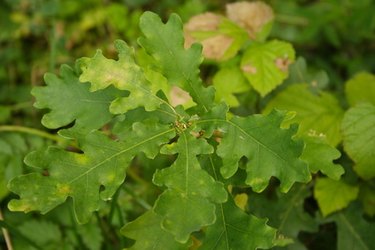
Unusual-looking growths on oak trees are often the result of a gall, a deformity caused by another living organism. Galls can occur on any part of the tree including leaves, twigs, flowers, even on acorns and on roots. The presence of a few galls typically causes no harm to an oak tree's health, but an invasion can kill young trees or thwart the growth of older trees.
Oak Galls
Video of the Day
Some oak galls have spikes or spines on them while others may be flat, dish-shaped, raised or lumpy in appearance. Galls are most often caused by tiny wasps or midge flies. These insects lay eggs on the tree and the gall forms to protect the larvae. Galls are very common on oak and other tree species and are formed by the tree's own tissues; therefore, the shape, size, texture and other characteristics of galls are as much the tree's doing as the insect's.
Video of the Day
Gall Formation
The exact mechanism the tree uses to create galls is unknown, and the life cycle of the wasp that initiates gall formation varies widely. Most spiny galls on oaks develop over a two-year period. A spring hatch of all female wasps occurs from old galls. These wasps lay eggs on oak leaves. A few months later, both male and female wasps emerge, mate and those females lay eggs on twigs, branches and other parts of the oak. When the larvae hatch, they bore into the tree and galls form in response to the invasion.
Inside Galls
Galls may contain up to 150 developing larvae. By the spring after females lay their eggs, galls become prominent on the tree. Inside the gall are the developing young wasps and a protein-rich food substance for them to consume. As the larvae feed, the gall around them grows. Once the larvae have finished developing and emerge as adult wasps, the interior of the gall is usually hollow and only the outside covering remains visible.
Common Spiked Varieties
Horned galls are the most common spiked variety on oaks. Caused by the Callirhytis wasp, these galls are seen on pin, black and water oaks. The galls vary in size and are covered in hornlike projections.
Xanthoteras gall wasps cause spiny vase galls, which resemble small pitchers or vases. This variety is covered in very small red or yellow spikes and they appear in the fall.
The hedgehog gall, initiated by Acraspis erinacei, occurs on the leaves of white oaks and has numerous short spines.